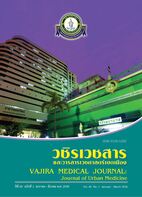|
Pansuksawat N, Earde PT, Kooncumchoo P, Rungroungdouyboon B, Pramodhyakul N., "Effects of I-Walk training on gait performances in patients with chronic stroke", Oct 2020; 64(4): p.243-254. Abstract
Objective: To determine the effects of I-Walk (Robotic-assisted gait device) training compared with over-ground walking training on motor impairments assessed by lower extremity scores, lower extremity angles during walking, and gait performances in patients with chronic stroke. Methods: A single blinded randomized controlled trial was conducted. Twenty four chronic stroke patients were randomly assigned into two groups; experimental group (n=12) and control group (n=12). For gait performances, patients in an experimental group received I-Walk training, while those in a control group received over-ground walking training. The duration of training was 60 min per day, 3 days per week for 8 weeks. The outcome measures included motor impairments assessed by the Fugl-Meyer Assessment of Lower Extremity (FMA-LE) scores, lower extremity angles during walking (hips, knees, ankles), and gait performances (step length, cadence, walking speed, stride length, and step length symmetry ratio). All variables were measured before and after the training period. Results: There was a statistically significant difference in motor impairments assessed by the FMA LE scores, lower extremity angles during walking on hips and knees, as well as gait performances, including step length, cadence, and walking speed, between the experimental and the control groups (p<0.05). In particular, the statistically significant changes were demonstrated in motor impairments assessed by the FMA-LE scores, lower extremity angles during walking on hips, knees, and ankles, as well as gait performances, including step length, cadence, walking speed, stride length, and step length symmetry ratio, before and after the I-Walk training in the experimental group (p<0.05). Conclusions: The I-Walking training could yield a statistically significant improvement of motor impairments assessed by FMA-LE scores, lower extremity angles during walking, and gait performances in chronic stroke patients. Nonetheless, further studies are recommended to elucidate and ratify the effective outcomes in patients with other stages of stroke, different ranges of lower extremity, and various spatiotemporal parameters. https://he02.tci-thaijo.org/index.php/VMED/article/view/230686
0 Comments
Leave a Reply. |
Archives
May 2023
Categories |
HoursM-F: 7am - 7pm
|
Telephone+66-(0)-2564-3001 ถึง 9 ต่อ 3247
|
|




 RSS Feed
RSS Feed